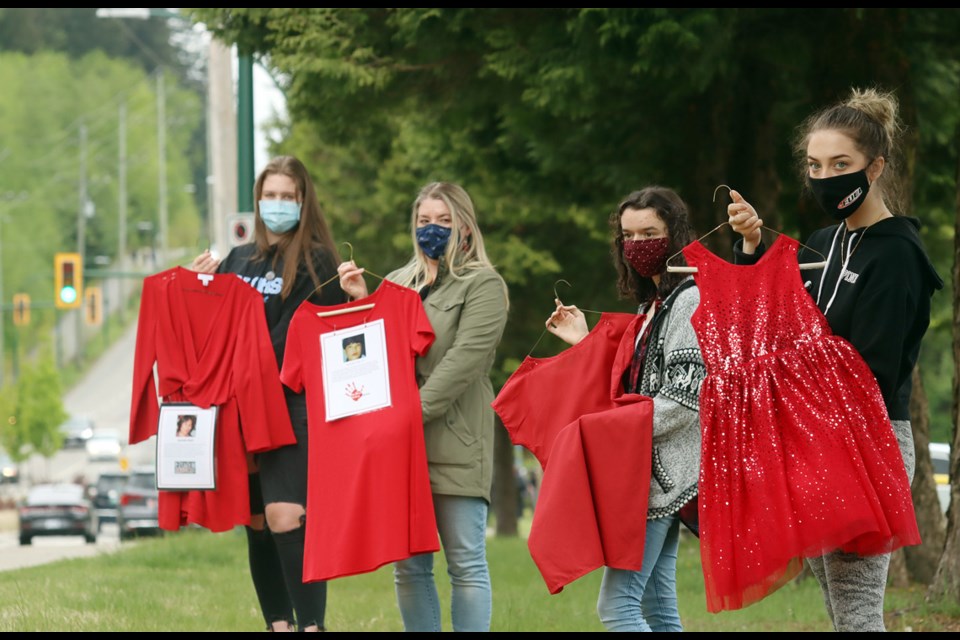For five days this week, Coquitlam commuters will be greeted by the ghostly spectre of 40 red dresses hanging from trees next to Dr. Charles Best Secondary.
Normally these dresses would be worn by a girl or woman for a party, a celebration or a date.
But this week, the 40 dresses collected by students and hanging outside the school on Como Lake Avenue will have a more sombre purpose as they mark Red Dress Day on Wednesday (May 5) in recognition of more than 1,000 Indigenous women who have gone missing or have been murdered.
Red Dress Day began seven years ago as a commemorative art installation by Métis artist Jamie Black. Since then, universities and colleges across Canada have participated in the Red Dress Project by hanging red dresses in trees to bring awareness to Indigenous issues.
This is the first time a Coquitlam high-school class has collected and hung dresses to raise awareness about injustices to Indigenous women, as recounted by the National Inquiry into Missing and Murdered Indigenous Women and Girls (MMIWG).
'BLOOD THAT HAS BEEN SPILT,' SAY STUDENTS ABOUT MISSING AND MURDERED WOMEN AND GIRLS
The dresses — donated by locals groups, collected by students, and, in some cases made by the school’s home economics teacher — are a colourful yet touching tribute to lives that have been lost in recent decades in Canada.
The students say they hope the installation, which has been approved by city officials on both sides of Como Lake Avenue, will raise awareness and spur action.
“I hope when people drive by they wonder who is supposed to be inside (these dresses),” said Jamie Livgard, who is of Cree Metis ancestry.
“I hope they Google it (the red dresses) and it educates them”
Some of the dresses have cards describing some of the missing teens, turning a school project into a heart-breaking memorial.
One card pinned to a simple red dress tells the story of Amanda Cook, 14, who went to a harvest fair in Rossburn, Manitoba. Her beaten body was found days later.
"It's the blood that has been spilt for many years," said Livgard, explaining why the dresses are red.
Students participating in the Red Dress Project have been studying the issue of MMIWG in their Social Justice 12 class, and believe Canadians can do more, starting with following up on the many recommendations of the national inquiry made nearly two years ago.
“The national inquiry called it a genocide,” said student Ciara Albrecht, “so it’s not just us, random students from Coquitlam who are concerned.”
Social Justice 12 teacher Megan Leslie said the course “empowers” students to “educate others,” and said letters to politicians urging action have also been sent by students with the aim of having the inquiry’s more than 200 recommendations addressed.
Student Ellisa Wright hopes something is done to address the long term effects of colonization and “trans-generational trauma” experienced by Indigenous people, noting that the deaths of the women and girls is an outcome of this trauma.
“It’s very shocking,” she said. “We need to do something to fix that.”
The students have earned the pride of Judge Marion Buller, a former Port Coquitlam judge and first female First Nations judge in B.C.
Buller, who now lives in Anmore, headed up the National Inquiry into Missing and Murdered Indigenous Women and Girls (MMIWG).
She said in an email to the Tri-City News the students are taking a bold stance by helping to promote concrete actions to remove systemic causes of violence and increase the safety of indigenous women and girls in Canada.
"I am very proud of the students and teachers in Social Justice 12 for their courage to support the Red Dress Project," Buller said.




